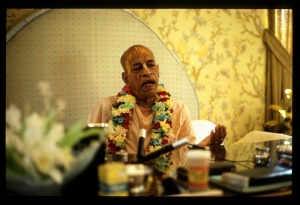SB 1.19.27: Difference between revisions
m (1 revision(s)) |
(Vanibot #0054 edit - transform synonyms into clickable links, which search similar occurrences) |
||
| (One intermediate revision by one other user not shown) | |||
| Line 1: | Line 1: | ||
{{info | {{info | ||
|speaker= | |speaker=Sūta Gosvāmī | ||
|listener=Sages of | |listener=Sages of Naimiṣāraṇya | ||
}} | }} | ||
[[Category:Srimad-Bhagavatam - Canto 01 Chapter 19]] | |||
[[Category:Bhagavatam Verses Spoken by Suta Gosvami - Vanisource|011927]] | |||
<div style="float:left">'''[[Srimad-Bhagavatam]] - [[SB 1|First Canto]] - [[SB 1.19: The Appearance of Sukadeva Gosvami|Chapter 19: The Appearance of Śukadeva Gosvāmī]]'''</div> | |||
<div style="float:right">[[File:Go-previous.png|link=SB 1.19.26]] '''[[SB 1.19.26]] - [[SB 1.19.28]]''' [[File:Go-next.png|link=SB 1.19.28]]</div> | |||
{{CompareVersions|SB|1.19.27|SB 1965|SB 1972-77}} | |||
{{RandomImage}} | |||
==== TEXT 27 ==== | ==== TEXT 27 ==== | ||
<div class="verse"> | |||
<div | :nigūḍha-jatruṁ pṛthu-tuṅga-vakṣasam | ||
nigūḍha-jatruṁ pṛthu-tuṅga-vakṣasam | :āvarta-nābhiṁ vali-valgūdaraṁ ca | ||
āvarta-nābhiṁ vali-valgūdaraṁ ca | :dig-ambaraṁ vaktra-vikīrṇa-keśaṁ | ||
dig-ambaraṁ vaktra-vikīrṇa-keśaṁ | :pralamba-bāhuṁ svamarottamābham | ||
pralamba-bāhuṁ svamarottamābham | |||
</div> | </div> | ||
| Line 18: | Line 23: | ||
==== SYNONYMS ==== | ==== SYNONYMS ==== | ||
<div class="synonyms"> | |||
<div | ''[//vanipedia.org/wiki/Special:VaniSearch?s=nigūḍha&tab=syno_o&ds=1 nigūḍha]'' — covered; ''[//vanipedia.org/wiki/Special:VaniSearch?s=jatrum&tab=syno_o&ds=1 jatrum]'' — collarbone; ''[//vanipedia.org/wiki/Special:VaniSearch?s=pṛthu&tab=syno_o&ds=1 pṛthu]'' — broad; ''[//vanipedia.org/wiki/Special:VaniSearch?s=tuṅga&tab=syno_o&ds=1 tuṅga]'' — swollen; ''[//vanipedia.org/wiki/Special:VaniSearch?s=vakṣasam&tab=syno_o&ds=1 vakṣasam]'' — chest; ''[//vanipedia.org/wiki/Special:VaniSearch?s=āvarta&tab=syno_o&ds=1 āvarta]'' — whirled; ''[//vanipedia.org/wiki/Special:VaniSearch?s=nābhim&tab=syno_o&ds=1 nābhim]'' — navel; ''[//vanipedia.org/wiki/Special:VaniSearch?s=vali&tab=syno_o&ds=1 vali]-[//vanipedia.org/wiki/Special:VaniSearch?s=valgu&tab=syno_o&ds=1 valgu]'' — striped; ''[//vanipedia.org/wiki/Special:VaniSearch?s=udaram&tab=syno_o&ds=1 udaram]'' — abdomen; ''[//vanipedia.org/wiki/Special:VaniSearch?s=ca&tab=syno_o&ds=1 ca]'' — also; ''[//vanipedia.org/wiki/Special:VaniSearch?s=dik&tab=syno_o&ds=1 dik]-[//vanipedia.org/wiki/Special:VaniSearch?s=ambaram&tab=syno_o&ds=1 ambaram]'' — dressed by all directions (naked); ''[//vanipedia.org/wiki/Special:VaniSearch?s=vaktra&tab=syno_o&ds=1 vaktra]'' — curled; ''[//vanipedia.org/wiki/Special:VaniSearch?s=vikīrṇa&tab=syno_o&ds=1 vikīrṇa]'' — scattered; ''[//vanipedia.org/wiki/Special:VaniSearch?s=keśam&tab=syno_o&ds=1 keśam]'' — hair; ''[//vanipedia.org/wiki/Special:VaniSearch?s=pralamba&tab=syno_o&ds=1 pralamba]'' — elongated; ''[//vanipedia.org/wiki/Special:VaniSearch?s=bāhum&tab=syno_o&ds=1 bāhum]'' — hands; ''[//vanipedia.org/wiki/Special:VaniSearch?s=su&tab=syno_o&ds=1 su]-[//vanipedia.org/wiki/Special:VaniSearch?s=amara&tab=syno_o&ds=1 amara]-[//vanipedia.org/wiki/Special:VaniSearch?s=uttama&tab=syno_o&ds=1 uttama]'' — the best among the gods (Kṛṣṇa); ''[//vanipedia.org/wiki/Special:VaniSearch?s=ābham&tab=syno_o&ds=1 ābham]'' — hue. | ||
</div> | </div> | ||
| Line 26: | Line 30: | ||
==== TRANSLATION ==== | ==== TRANSLATION ==== | ||
<div class="translation"> | |||
<div | |||
His collarbone was fleshy, his chest broad and thick, his navel deep and his abdomen beautifully striped. His arms were long, and curly hair was strewn over his beautiful face. He was naked, and the hue of his body reflected that of Lord Kṛṣṇa. | His collarbone was fleshy, his chest broad and thick, his navel deep and his abdomen beautifully striped. His arms were long, and curly hair was strewn over his beautiful face. He was naked, and the hue of his body reflected that of Lord Kṛṣṇa. | ||
</div> | </div> | ||
| Line 34: | Line 37: | ||
==== PURPORT ==== | ==== PURPORT ==== | ||
<div class="purport"> | |||
<div | |||
His bodily features indicate him to be different from common men. All the signs described in connection with the bodily features of Śukadeva Gosvāmī are uncommon symptoms, typical of great personalities, according to physiognomical calculations. His bodily hue resembled that of Lord Kṛṣṇa, who is the supreme among the gods, demigods and all living beings. | His bodily features indicate him to be different from common men. All the signs described in connection with the bodily features of Śukadeva Gosvāmī are uncommon symptoms, typical of great personalities, according to physiognomical calculations. His bodily hue resembled that of Lord Kṛṣṇa, who is the supreme among the gods, demigods and all living beings. | ||
</div> | </div> | ||
__NOTOC__ | |||
<div style="float:right; clear:both;">[[File:Go-previous.png|link=SB 1.19.26]] '''[[SB 1.19.26]] - [[SB 1.19.28]]''' [[File:Go-next.png|link=SB 1.19.28]]</div> | |||
__NOTOC__ | |||
__NOEDITSECTION__ | |||
Latest revision as of 18:06, 17 February 2024

A.C. Bhaktivedanta Swami Prabhupada
TEXT 27
- nigūḍha-jatruṁ pṛthu-tuṅga-vakṣasam
- āvarta-nābhiṁ vali-valgūdaraṁ ca
- dig-ambaraṁ vaktra-vikīrṇa-keśaṁ
- pralamba-bāhuṁ svamarottamābham
SYNONYMS
nigūḍha — covered; jatrum — collarbone; pṛthu — broad; tuṅga — swollen; vakṣasam — chest; āvarta — whirled; nābhim — navel; vali-valgu — striped; udaram — abdomen; ca — also; dik-ambaram — dressed by all directions (naked); vaktra — curled; vikīrṇa — scattered; keśam — hair; pralamba — elongated; bāhum — hands; su-amara-uttama — the best among the gods (Kṛṣṇa); ābham — hue.
TRANSLATION
His collarbone was fleshy, his chest broad and thick, his navel deep and his abdomen beautifully striped. His arms were long, and curly hair was strewn over his beautiful face. He was naked, and the hue of his body reflected that of Lord Kṛṣṇa.
PURPORT
His bodily features indicate him to be different from common men. All the signs described in connection with the bodily features of Śukadeva Gosvāmī are uncommon symptoms, typical of great personalities, according to physiognomical calculations. His bodily hue resembled that of Lord Kṛṣṇa, who is the supreme among the gods, demigods and all living beings.